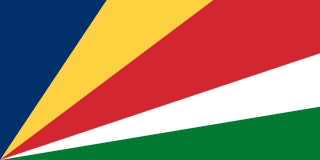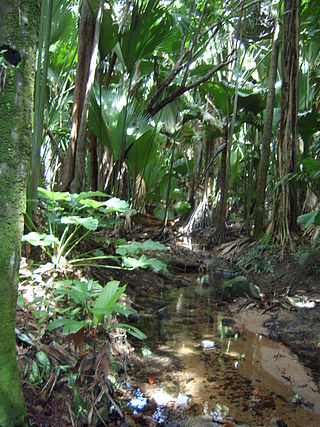
Seychelles, officially the Republic of Seychelles, is an island country and archipelagic state consisting of 155 islands in the Indian Ocean. Its capital and largest city, Victoria, is 1,500 kilometres east of mainland Africa. Nearby island countries and territories include the Comoros, Madagascar, Mauritius, and the French overseas departments of Mayotte and Réunion to the south; and the Chagos Archipelago to the east. Seychelles is the smallest country in Africa as well as the least populated sovereign African country, with an estimated population of 100,600 in 2022.

The Arecaceae is a family of perennial, flowering plants in the monocot order Arecales. Their growth form can be climbers, shrubs, tree-like and stemless plants, all commonly known as palms. Those having a tree-like form are colloquially called palm trees. Currently, 181 genera with around 2,600 species are known, most of which are restricted to tropical and subtropical climates. Most palms are distinguished by their large, compound, evergreen leaves, known as fronds, arranged at the top of an unbranched stem, except for the Hyphaene genus, who has branched palms. However, palms exhibit an enormous diversity in physical characteristics and inhabit nearly every type of habitat within their range, from rainforests to deserts.

The coconut tree is a member of the palm tree family (Arecaceae) and the only living species of the genus Cocos. The term "coconut" can refer to the whole coconut palm, the seed, or the fruit, which botanically is a drupe, not a nut. They are ubiquitous in coastal tropical regions and are a cultural icon of the tropics.

Lodoicea, commonly known as the sea coconut, coco de mer, or double coconut, is a monotypic genus in the palm family. The sole species, Lodoicea maldivica, is endemic to the islands of Praslin and Curieuse in the Seychelles. It has the largest seed in the plant kingdom. It was also formerly found on the small islets of St Pierre, Chauve-Souris, and Ile Ronde, all located near Praslin, but had become extinct there for a time until recently reintroduced.

Seychelles giant day gecko is a diurnal subspecies of geckos. It lives on the island Praslin in the Seychelles and typically inhabits trees and dwellings. The Seychelles giant day gecko feeds on insects and nectar.

Praslin is the second largest island (38.5 km2) of the Inner Seychelles, lying 44 km (27 mi) northeast of Mahé. Praslin has a population of around 7,533 people and comprises two administrative districts: Baie Sainte Anne and Grand' Anse. The main settlements are the Baie Ste Anne, Anse Volbert and Grand' Anse.
Curieuse Island is a small granitic island 1.13 sq mi (2.9 km2) in the Seychelles close to the north coast of the island of Praslin. Curieuse is notable for its bare red earth intermingled with the unique coco de mer palms, one of the cultural icons of the Seychelles, only growing on the two neighboring islands.

The Seychelles black parrot, Praslin parrot or kato nwar is a sombre-coloured, medium-sized parrot endemic to the Seychelles. Historically, it has been treated as a subspecies of the lesser vasa parrot, although it shows morphological, ecological and behavioural differences. Recent phylogenetic research indicates that the Seychelles population has a long history of isolation and may be sister to the rest of Coracopsis. It is the national bird of the Seychelles.

Vallée de Mai Nature Reserve is a nature park and UNESCO World Heritage Site on the island of Praslin, Seychelles. It consists of a well-preserved palm forest, flagship species made up of the island endemic coco de mer, as well as five other endemic palms.

The coat of arms of the Republic of Seychelles shows a shield, in which a giant tortoise is located on green grounds. On the ground there is a coco de mer palm tree. Behind it there is a blue sea with two islands and a sail ship to be seen. The shield is enthroned by a silver helmet, on which a white-tailed tropicbird is located above blue and white waves. The shield is supported by two white sailfish. Beneath the shield the motto of Seychelles is stated: "Finis Coronat Opus".
Drift seeds and drift fruits are seeds and fruits adapted for long-distance dispersal by water. Most are produced by tropical trees, and they can be found on distant beaches after drifting thousands of miles through ocean currents. This method of propagation has helped many species of plant such as the coconut colonize and establish themselves on previously barren islands. Consequently, drift seeds and fruits are of interest to scientists who study these currents.

The giant bronze gecko is a species of lizard in the family Gekkonidae endemic to Seychelles.

The Granitic Seychelles are the islands in Seychelles which lie in central position on the Seychelles Bank and are composed of granite rock. They make up the majority of the Inner Islands, which in addition include the coral islands along of the rim of the Seychelles Bank, namely Bird Island and Denis Island. The Granitic Seychelles contrast with the Coralline Seychelles or the Outer Islands, several island groups made up of low coral islands with dry, infertile soils.

The wildlife of Seychelles comprises the flora and fauna of the Seychelles islands off the eastern coast of Africa in the western Indian Ocean.
Dwarf coconut is a range of varieties of coconut palm. The use of the word “dwarf” here does not refer to the tree's size, as it can reach heights of 50–100 feet which is certainly not a dwarf. Instead, the dwarf designation refers to the size at which it will begin to produce the coveted or harvestable coconut.

The coconut crab is a terrestrial species of giant hermit crab, and is also known as the robber crab or palm thief. It is the largest terrestrial arthropod known, with a weight of up to 4.1 kg (9 lb). The distance from the tip of one leg to the tip of another can be as wide as 1 m. It is found on islands across the Indian and Pacific Oceans, as far east as the Gambier Islands, Pitcairn Islands and Caroline Island and as far west as Zanzibar. While its range broadly shadows the distribution of the coconut palm, the coconut crab has been extirpated from most areas with a significant human population such as mainland Australia and Madagascar.

Jean-Nicolas Céré was a French botanist and agronomist born on the Indian Ocean Isle de France but educated in Brittany and Paris. On the Isle de France, he was befriended by Pierre Poivre (1719–1786), administrator of the Isle de France and Ile Bourbon (Réunion), who he assisted in the cultivation of spices. When Poivre was recalled to France in 1773, Céré was appointed Director of the Royal Garden at Monplaisir, a position he held from 1775 to the time of his death in 1810.

Coquito nuts are the fruits from a feather-leaved palm, Jubaea chilensis, native to Chile, having a thick trunk from which is obtained a sugary sap used for making wine and a syrup, and widely cultivated as an ornamental in warm dry regions. Coquito nuts look like miniature coconuts and have a very similar flavor to coconuts. They have a brown exterior and a white interior with a hollow center. They measure about 1⁄2 to 3⁄4 inch in diameter. They are completely edible, and are crunchy, with an almond-like sweetness.

The Praslin National Park and surrounding areas Important Bird Area lies in the southern part of the island of Praslin in the Seychelles archipelago of the western Indian Ocean.


















